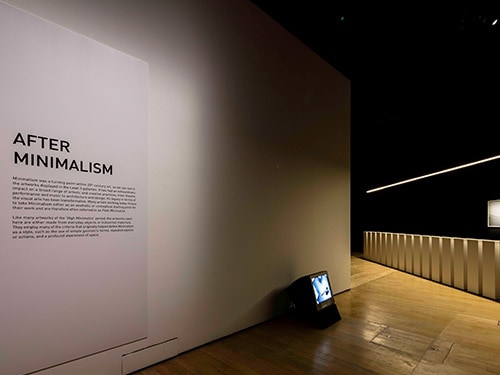

After Minimalism


Minimalism was a turning point within 20th century art, as we can see in the artworks displayed in the Level 3 galleries. It has had an extraordinary impact on a broad range of artistic and creative practices, from theatre, performance and music to architecture and design. Its legacy in terms of the visual arts has been transformative. Many artists working today choose to take Minimalism either as an aesthetic or conceptual starting point for their work and are therefore often referred to as Post-Minimalists.
Like many artworks of the High Minimalist period, artworks seen here are either made from everyday objects or industrial materials. They employ many of the criteria that helped originally define Minimalism as a style, such as the use of simple geometric forms, repeated objects or actions and a profound awareness of space.
 by Morgan Wong (2016–ongoing).jpg)
Time Needle Series (No. 1–25) by Morgan Wong (2016–ongoing)
Metal powder and glass
25 parts, each 11 x 0.5 cm (diameter)
The three artworks on view by Morgan Wong are based on the traditional Chinese saying that “with constant grinding an iron bar can become a needle”. The lesson to be learnt is that with sufficient application and determination, anything is possible. The action of filing an iron bar, repeated many times, has become an intense and ongoing durational performance for Wong. He began performing the act described in the Chinese idiom in 2013, firstly in China and then in London, and continues the arduous and perhaps futile work of filing down an iron bar until a needle is made, on a daily basis.
Simple actions echoed by repeated geometries are some of the most recognisable attributes of a Minimalist aesthetic. The photographs and video on view document the bleak simplicity and conviction of Wong’s work. The iron filings are saved and placed in needle-like glass phials presented on a series of identical white plinths to form the installation at the centre of this gallery.
Also on view are the works:
- Where is the Sage (2011)
- Filing Down a Steel Bar until a Needle is Made (2013–ongoing)

.jpg)
A Thing Is a Hole in a Thing It Is Not by Gerald Byrne (2010)
Video, high definition, 5 channels, 16:9 format (each), colour and sound (mono), varying duration, 2 min–30 min (loop)
Dimensions variable
Gerard Byrne is a contemporary artist from Ireland who works in film and installation. This multi-screen video installation explores the history of Minimalism. Five films move back and forth between re-staged moments Minimalist art history as well as contemporary scenes in museums showing Minimalist artworks being installed.
In one film, a 1964 radio conversation between three of the giants of Minimalism, Frank Stella, Donald Judd and Dan Flavin, is re-created on screen. Another depicts the drive that artist Tony Smith took down an unfinished highway in the 1950s. The story of his experience became an influential text for Minimalism. Other screens show key artworks of the ‘High Minimalist’ period including Stella’s Tuxedo Junction (1960) and Robert Morris’ Column (1961). The title of the work further refers to the roots of Minimalism, taken from quote from Carl Andre that refers to the Minimalist idea that the space between artworks is just as important as the art itself.
Byrne’s five screens, installed almost as Minimalist objects within the gallery, both meditate on the traditions of Minimalism, whilst also conveying narratives that act as a subtle critique or parody of Minimalism’s severity.
.jpg)
Haumea by Tawatchai Puntusawasdi (2016)
Aluminium plates and rivets, 210 x 120 x 218 cm
Tawatchai Puntusawasdi is a contemporary artist from Thailand who creates monumental sculptures that skew and contort visual reality.
This piece draws on the traditions of both Minimalist art and scientific knowledge. It is named after the dwarf planet, Haumea which orbits the Sun beyond Neptune. Haumea is a source of fascination for astronomers due to its rapid rotation and unusual elongated shape. Because it spins so quickly, Haumea’s form has become distorted over time, and now resembles the dramatic elliptical contour of Puntusawasdi’s sculpture.
Like many Minimalist artists, Puntusawasdi encourages a heightened awareness of space, drawing attention to the space around his artwork, and the volumes of space between artworks. He uses complex mathematical calculations to generate forms that are then constructed using everyday materials, without the use of digital technology. His use of simple materials, repeating patterns and geometric forms is clearly Minimalist in nature. The unexpected morphology of his artworks also hints at other planes of existence, tangentially referencing ideas in Buddhism, that were so influential to Minimalist artists in the 1960s.
